Chapter 16: The Move to Bagua Chica
AS TOLD BY GRO AGERSTEN

The time in Tarma was now behind us, and it was time to take the next step forward in God’s plan for us. It would be a long drive to Bagua Chica; first to the coast, then north along the coast till it was time to go east over the Andes mountains again and into the jungle.
We left Tarma at midnight and drove all night to Lima. We stopped first on the outskirts of Lima and slept for an hour before driving into the city at 8 o'clock in the morning. We had several things to take care of there before we could continue north. We made a brief visit to the Scandinavian Seamen's Church. Then we met the moving truck at Elektrolux, and loaded our newly purchased paraffin refrigerator. We finally finished our errands around 6 pm,and continued our journey north through the desert. At 3 am we were very tired, so we took a small exit into the desert sand and slept for a couple of hours. We took turns driving all day with a few stops and arrived in Bagua at eight o'clock in the evening, November 8th, 1968. Maino and Lewi had slept most of the trip and felt great when we arrived, but John and I were exhausted!
We left Tarma at midnight and drove all night to Lima. We stopped first on the outskirts of Lima and slept for an hour before driving into the city at 8 o'clock in the morning. We had several things to take care of there before we could continue north. We made a brief visit to the Scandinavian Seamen's Church. Then we met the moving truck at Elektrolux, and loaded our newly purchased paraffin refrigerator. We finally finished our errands around 6 pm,and continued our journey north through the desert. At 3 am we were very tired, so we took a small exit into the desert sand and slept for a couple of hours. We took turns driving all day with a few stops and arrived in Bagua at eight o'clock in the evening, November 8th, 1968. Maino and Lewi had slept most of the trip and felt great when we arrived, but John and I were exhausted!
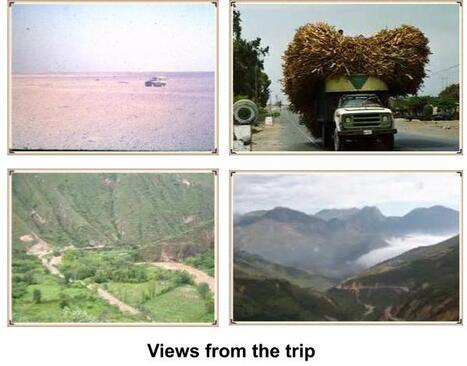
In a letter home I wrote about our arrival and the first few days in Bagua :
“We had been told that the house we were going to rent would be finished before we left Tarma. However, when I saw the house, I didn’t know whether to laugh or cry. We were shown to an "apartment" located on the third floor of a fairly new brick building. It consisted of two small rooms with an open window in each of the rooms. There was no kitchen. Out in the hallway there was a toilet and a water tap that was shared with several other similar "apartments''. It smelled terrible,because it had been used for a long time, but without water. Everything was terribly dirty. We brought up our camping beds and suitcases, but the rest we had to store in a larger room downstairs with an exit door straight out to a small space where we could park. Since we were exhausted, we fell asleep on the camping beds after a quick wash out in the hallway. When the truck arrived the next day, we were allowed to stack all our furniture and belongings in the room on the first floor.”
The situation was desperate! We could not possibly stay here with two small children any longer than absolutely necessary. There was nowhere to take care of ourselves and the kids, and nowhere to cook, and there were very few cafes and restaurants in Bagua at the time. Maino and especially Lewi had so many mosquito bites after the first night that someone we met the next morning asked if they had measles! That morning we were invited to the home of brother Jose and his wife for breakfast.The breakfast food they served was different than what we were used to, but it tasted good. They had a simple, but well kept home. When we told him about our reaction to the "apartment", and that we would immediately need to look for something else, Jose explained that this was not really the place he had told us about. So what had happened? Well, the owner, who was a farmer and lived in the countryside, had, like many others, built a house in the settler town of Bagua Chica. When he heard that someone wanted to rent the house, he saw this as an opportunity to have it fixed up on the inside as the rent would cover his expenses. He was happy to rent out the house with the exception of a room with its own entrance which he wanted available when he had to visit Bagua to shop or to sell rice. But then he got "cold feet". He got worried that we wouldn’t come and he would not be able to rent out the house to anyone else. If that happened, he would not be able to cover the expenses of the renovation, and he would have problems paying his bills. And so, he decided to do nothing! By the time Jose discovered this, there was no alternative but to rent the "apartment" we were shown on our arrival.
“We had been told that the house we were going to rent would be finished before we left Tarma. However, when I saw the house, I didn’t know whether to laugh or cry. We were shown to an "apartment" located on the third floor of a fairly new brick building. It consisted of two small rooms with an open window in each of the rooms. There was no kitchen. Out in the hallway there was a toilet and a water tap that was shared with several other similar "apartments''. It smelled terrible,because it had been used for a long time, but without water. Everything was terribly dirty. We brought up our camping beds and suitcases, but the rest we had to store in a larger room downstairs with an exit door straight out to a small space where we could park. Since we were exhausted, we fell asleep on the camping beds after a quick wash out in the hallway. When the truck arrived the next day, we were allowed to stack all our furniture and belongings in the room on the first floor.”
The situation was desperate! We could not possibly stay here with two small children any longer than absolutely necessary. There was nowhere to take care of ourselves and the kids, and nowhere to cook, and there were very few cafes and restaurants in Bagua at the time. Maino and especially Lewi had so many mosquito bites after the first night that someone we met the next morning asked if they had measles! That morning we were invited to the home of brother Jose and his wife for breakfast.The breakfast food they served was different than what we were used to, but it tasted good. They had a simple, but well kept home. When we told him about our reaction to the "apartment", and that we would immediately need to look for something else, Jose explained that this was not really the place he had told us about. So what had happened? Well, the owner, who was a farmer and lived in the countryside, had, like many others, built a house in the settler town of Bagua Chica. When he heard that someone wanted to rent the house, he saw this as an opportunity to have it fixed up on the inside as the rent would cover his expenses. He was happy to rent out the house with the exception of a room with its own entrance which he wanted available when he had to visit Bagua to shop or to sell rice. But then he got "cold feet". He got worried that we wouldn’t come and he would not be able to rent out the house to anyone else. If that happened, he would not be able to cover the expenses of the renovation, and he would have problems paying his bills. And so, he decided to do nothing! By the time Jose discovered this, there was no alternative but to rent the "apartment" we were shown on our arrival.

We left to look at the house. It was quickly clear to us that a lot had to be done to make it livable, but it certainly had potential! After looking around a little more in the small dusty town, we realized there was nothing else available. At a little shop we bought a mosquito net to cover the children's beds. John and I had not been terribly bothered by the mosquitoes, although we had been bitten a few times.
The next day we went back to the unfinished house. It was built partly of brick and partly of dried clay/straw blocks. There were three large rooms, besides the room the owner wanted available for himself. The largest had two doors out to the street. There were cement floors and whitewashed walls and ceilings in this room. The other rooms had dirt floors and no ceilings. There was no toilet, nor any plumbing, water, or electricity. The windows were open, but at least there were iron bars in the openings. It kind of reminded us of a prison, but we saw that that was normal in Peru.
The next day we went back to the unfinished house. It was built partly of brick and partly of dried clay/straw blocks. There were three large rooms, besides the room the owner wanted available for himself. The largest had two doors out to the street. There were cement floors and whitewashed walls and ceilings in this room. The other rooms had dirt floors and no ceilings. There was no toilet, nor any plumbing, water, or electricity. The windows were open, but at least there were iron bars in the openings. It kind of reminded us of a prison, but we saw that that was normal in Peru.
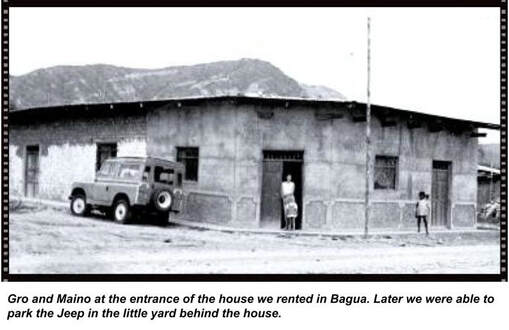
We were able to negotiate with the owner and came to an agreement. The owner would pay to put flooring and ceilings in the rooms where those were missing. He would also pay for the materials needed to install water, drainage, and electricity. However, we would have to do the work involved in these installations ourselves or pay someone to do it. The rent was significantly lower than in Tarma, so we agreed and signed the lease. There was a water connection out in the street, and sewer pipes ran near to the house, so everything was in place to install plumbing for water and attach sewer pipes. Electricity was installed from the posts on the other side of the street. The owner contacted two painters who painted the ceiling and the walls in the room that was finished. This was done quickly, and we were happy and relieved to move in a few days later.
Even if the house was not completely finished, it was much better than where we had been staying. Here we had the opportunity to make our own food. All our furniture was placed in the large finished room. We unpacked beds and some other furniture on the first day. Space was tight since our beds had to be in the "living area", but we knew it was only temporary. The fridge, the dining table with chairs and the gas stove that we had with us from Tarma was placed at the other end of the room. We really had an "open kitchen” solution! The bench with cabinets and drawers and the top cabinet John made in Tarma came in handy. The bedroom and living room were one open area until the other rooms were finished.
In a letter to our parents, I wrote: “One of the best things about the house is a walled courtyard at the back of the house with a high gate in from the street. The owner says we can use that space, as long as he can tie his donkey there when he is in town. We cleaned up that area and planted a small garden spot outside the door that went into the third room. This room will be a workshop and storage for us once the floor and ceiling are finished. There is also space for parking for the Land Rover in the courtyard.
Little by little, we got electricity, water, and sewer installed. Then we were able to build a bathroom into a corner of the second room with a toilet, sink, and shower. The rest of this second room was divided into two bedrooms with light walls and cabinets. We were also able to set up a kitchen sink with a simple counter. Mosquito nets went up inside all the window openings, and then curtains. Now, the house was tight, and rats, mosquitoes and flies could not easily enter. Pure luxury!
But it was not entirely easy to live there while all this was going on. There were large double doors toward the street, but no doors between the rooms. While they were plastering the walls and floors in the other rooms, we wandered around in a cloud of sand and cement dust. Besides, there was a lot of noise from the hammering and construction around us. To bathe, we went to the river that flows through Bagua. We drove a bit outside the city where we could swim and wash clothes undisturbed. The heat in Bagua was probably one of the hardest things to get accustomed to. Sometimes we woke up in the morning and were drenched in sweat. The temperature stayed between 85 and 100 degrees, but eventually we got used to the heat. The human body has an amazing ability to acclimatize.”
Even if the house was not completely finished, it was much better than where we had been staying. Here we had the opportunity to make our own food. All our furniture was placed in the large finished room. We unpacked beds and some other furniture on the first day. Space was tight since our beds had to be in the "living area", but we knew it was only temporary. The fridge, the dining table with chairs and the gas stove that we had with us from Tarma was placed at the other end of the room. We really had an "open kitchen” solution! The bench with cabinets and drawers and the top cabinet John made in Tarma came in handy. The bedroom and living room were one open area until the other rooms were finished.
In a letter to our parents, I wrote: “One of the best things about the house is a walled courtyard at the back of the house with a high gate in from the street. The owner says we can use that space, as long as he can tie his donkey there when he is in town. We cleaned up that area and planted a small garden spot outside the door that went into the third room. This room will be a workshop and storage for us once the floor and ceiling are finished. There is also space for parking for the Land Rover in the courtyard.
Little by little, we got electricity, water, and sewer installed. Then we were able to build a bathroom into a corner of the second room with a toilet, sink, and shower. The rest of this second room was divided into two bedrooms with light walls and cabinets. We were also able to set up a kitchen sink with a simple counter. Mosquito nets went up inside all the window openings, and then curtains. Now, the house was tight, and rats, mosquitoes and flies could not easily enter. Pure luxury!
But it was not entirely easy to live there while all this was going on. There were large double doors toward the street, but no doors between the rooms. While they were plastering the walls and floors in the other rooms, we wandered around in a cloud of sand and cement dust. Besides, there was a lot of noise from the hammering and construction around us. To bathe, we went to the river that flows through Bagua. We drove a bit outside the city where we could swim and wash clothes undisturbed. The heat in Bagua was probably one of the hardest things to get accustomed to. Sometimes we woke up in the morning and were drenched in sweat. The temperature stayed between 85 and 100 degrees, but eventually we got used to the heat. The human body has an amazing ability to acclimatize.”
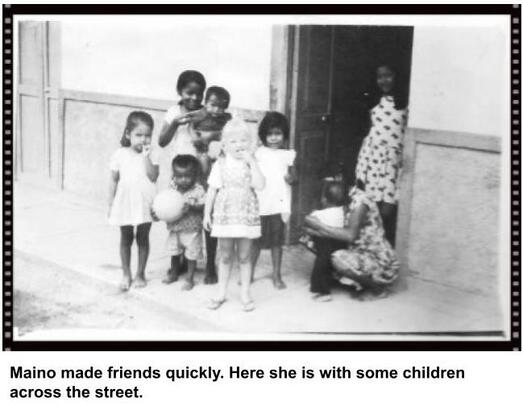
When we read the letters home from these first few weeks in Bagua, it surprises us how quickly everything came together. Three or four weeks after we arrived, most things were in order. But of course both we and others worked from early morning until late at night to finish it. Minor improvements were made as we had time, but finally we were able to start the work we had come to do, and soon we were in full swing. In a subsequent letter home, I wrote:
“We quickly discovered that there is not a big selection of food items here in town, and what is available, is more expensive than in Tarma. In mid November, John had to drive to Chiclayo with a man from the Baptist church who was seriously ill, and I took the opportunity to send a long list with him to buy various foods. It was like Christmas Eve here when John returned with dry goods and canned goods, besides some other things we needed from Chiclayo. You can imagine how happy we are with the paraffin refrigerator. It cools nicely and has room for a lot with a fairly large freezer at the top. Here in this heat, the food goes bad in no time if it is not stored cold. Just think of fresh food such as fish, meat and cold cuts and prepared food! It is also delicious to have cold water. The water must be boiled and cooled before we can drink it. Buying meat is a cumbersome process. It is only sold in one place early in the morning. You have to be there at six o'clock and stand in line. One day you may get cow meat, another day pork, then fish, etc. However, it doesn’t follow any particular system, so you never know what
“We quickly discovered that there is not a big selection of food items here in town, and what is available, is more expensive than in Tarma. In mid November, John had to drive to Chiclayo with a man from the Baptist church who was seriously ill, and I took the opportunity to send a long list with him to buy various foods. It was like Christmas Eve here when John returned with dry goods and canned goods, besides some other things we needed from Chiclayo. You can imagine how happy we are with the paraffin refrigerator. It cools nicely and has room for a lot with a fairly large freezer at the top. Here in this heat, the food goes bad in no time if it is not stored cold. Just think of fresh food such as fish, meat and cold cuts and prepared food! It is also delicious to have cold water. The water must be boiled and cooled before we can drink it. Buying meat is a cumbersome process. It is only sold in one place early in the morning. You have to be there at six o'clock and stand in line. One day you may get cow meat, another day pork, then fish, etc. However, it doesn’t follow any particular system, so you never know what
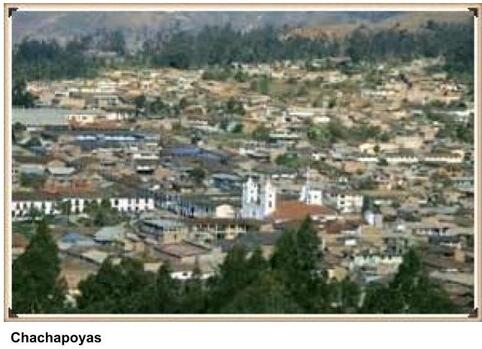
you can buy or if you are able to get anything at all. So it is good to be able to buy a good quantity when we are there and then store it in the fridge and freezer. There are few vegetables, and there is not a large selection of fruit either. We were spoiled with the abundance of vegetables and fruits in Tarma - it was cheaper there too. But it will probably get better as the town grows. New people are constantly moving in.”
At the beginning of December we had to drive further up the mountains a little south of Bagua to Chachapoyas, the capital of the county of Amazonas. We had to go there as foreigners to register the move to Bagua Chica. Chachapoyas is located at 7600 feet above sea level, and it is an old town with many houses in Spanish colonial style. There are also many ruins and archeological finds after the original inhabitants of this area, Los Chachapoyas, the native tribe that the city was named for. But we did not have time to look at any of this. We took care of the documents and the relocation notice the day after we arrived, so we only spent two nights in a cheap hotel before we returned home again.
At the beginning of December we had to drive further up the mountains a little south of Bagua to Chachapoyas, the capital of the county of Amazonas. We had to go there as foreigners to register the move to Bagua Chica. Chachapoyas is located at 7600 feet above sea level, and it is an old town with many houses in Spanish colonial style. There are also many ruins and archeological finds after the original inhabitants of this area, Los Chachapoyas, the native tribe that the city was named for. But we did not have time to look at any of this. We took care of the documents and the relocation notice the day after we arrived, so we only spent two nights in a cheap hotel before we returned home again.
EVANGELISM, A CONGREGATION AND SUNDAY SCHOOL

In a letter home in mid-December, I wrote: “We have now made contact with a small group of Pentecostal friends here, actually two families. They received salvation at the place they moved from, and have built a small bamboo hut on the plot where one of the families lives. There they gather for prayer and testimony. It is very primitive with dirt floors and a roof of palm leaves. The benches are planks that are laid over three blocks. They get light from a kerosene lantern. The leader could not read or write, but he had good insight into God's Word.
Last Sunday, John was traveling inland to Chiriaco. The road goes just a little further from there to the small village, Nazareth, where the Aguaruna tribe lives. There he sold Bibles and held services in the evening. We had bought a lot of Bibles and Gospels and took them with us when we moved. There seems to be a great need for Bibles, even though there are many here who cannot read.”
The first Sunday of the new year - 1969 - we held the first Sunday school with the small Pentecostal group. It exceeded all our expectations! We were forty people in all, eight adults and the rest big and small children. We sang together first, including many children's songs. Then I taught the children and showed pictures on a flannelgraph board, and John taught the adults in the leader’s house. The Friday before, I had walked around and handed out invitations and tracts in the neighborhood of the little church building. It seemed to have borne fruit. Everyone I stopped and talked to was nice and wanted to know what a Sunday school was. It was a nice time together, and gradually the number that came increased. Some of the adults were eventually baptized as well.
In February, Lewi became ill and had a high fever. It turned out to be infected tonsils, and the doctor prescribed antibiotics. This helped and he got better. But then he started vomiting and had a stomach ache. He almost didn’t want to eat and certainly did not want milk. He lost a lot of weight, and we were very worried about him. The only doctor in Bagua was out traveling, but we were given some medicine at a small pharmacy. But it did not help. It seemed to be getting worse, and he cried and screamed a lot for a couple of days. Lewi was very calm from the time he was born and rarely cried, so this was unusual and scary. The neighbors came with local advice such as giving him a concoction of various herbs, or rubbing him in with a raw egg. One neighbor came with a guinea pig and said we should rub the guinea pig over his stomach,then he would recover. We had prayed to God for Lewi, and one night when we took turns walking around rocking him to try to calm him down a bit, we laid our hands on him and prayed once more. He soon stopped crying, and he slept until well into the next day. We became a little worried and had to listen to hear if he was still breathing. He was! When he woke up, he wanted to eat a little and kept the food down. Eventually he ate well again and put on weight. For us, it was a miracle. The neighbors were also surprised that he recovered so quickly. And we were happy and grateful!
Last Sunday, John was traveling inland to Chiriaco. The road goes just a little further from there to the small village, Nazareth, where the Aguaruna tribe lives. There he sold Bibles and held services in the evening. We had bought a lot of Bibles and Gospels and took them with us when we moved. There seems to be a great need for Bibles, even though there are many here who cannot read.”
The first Sunday of the new year - 1969 - we held the first Sunday school with the small Pentecostal group. It exceeded all our expectations! We were forty people in all, eight adults and the rest big and small children. We sang together first, including many children's songs. Then I taught the children and showed pictures on a flannelgraph board, and John taught the adults in the leader’s house. The Friday before, I had walked around and handed out invitations and tracts in the neighborhood of the little church building. It seemed to have borne fruit. Everyone I stopped and talked to was nice and wanted to know what a Sunday school was. It was a nice time together, and gradually the number that came increased. Some of the adults were eventually baptized as well.
In February, Lewi became ill and had a high fever. It turned out to be infected tonsils, and the doctor prescribed antibiotics. This helped and he got better. But then he started vomiting and had a stomach ache. He almost didn’t want to eat and certainly did not want milk. He lost a lot of weight, and we were very worried about him. The only doctor in Bagua was out traveling, but we were given some medicine at a small pharmacy. But it did not help. It seemed to be getting worse, and he cried and screamed a lot for a couple of days. Lewi was very calm from the time he was born and rarely cried, so this was unusual and scary. The neighbors came with local advice such as giving him a concoction of various herbs, or rubbing him in with a raw egg. One neighbor came with a guinea pig and said we should rub the guinea pig over his stomach,then he would recover. We had prayed to God for Lewi, and one night when we took turns walking around rocking him to try to calm him down a bit, we laid our hands on him and prayed once more. He soon stopped crying, and he slept until well into the next day. We became a little worried and had to listen to hear if he was still breathing. He was! When he woke up, he wanted to eat a little and kept the food down. Eventually he ate well again and put on weight. For us, it was a miracle. The neighbors were also surprised that he recovered so quickly. And we were happy and grateful!
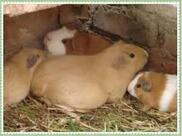
John received many invitations to attend conventions and meetings in other congregations in the hills around Bagua, both from the Baptists and the Nazarene Church, which is quite similar to the Baptist Church, but somewhat more conservative. In some places the means of transport were horses, and for one of the conventions they spent 8 hours on horseback from the place where the road ended. People came great distances to join. The communal dinner was usually guinea pigs fried on skewers. It actually tasted good. It is common to keep guinea pigs in a corner of the kitchen where they were fed vegetable scraps and grass. It may seem an odd meat source to us, but It is a good supplement in the diet of people in the mountains and in these settlements.
All in all we could see that the time before us in the jungle would be both busy and full of adventures, but the best thing was that we knew God would be with us even here.
All in all we could see that the time before us in the jungle would be both busy and full of adventures, but the best thing was that we knew God would be with us even here.